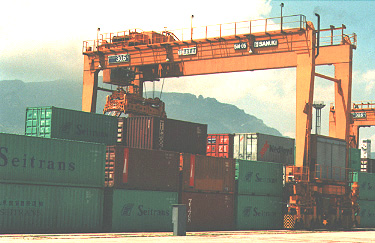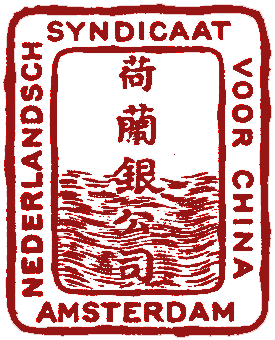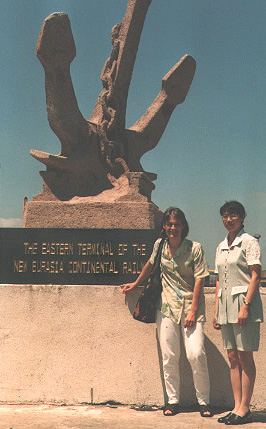![]()
|
Map of Lianyungang and environment |
Kaart van Lianyungang en omgeving |
Lianyungang is situated on the coast of the Yellow Sea somewhere in the middle of China's entire coastline, in the northeastern part of the economically important coastal province of Jiangsu. It is one of the fourteen so-called 'open' coastal cities, with an Economic and Technological Development Zone where foreign investors can enjoy special privileges. The city is also the eastern terminal of the New Eurasian Continental Bridge, the railway that connects China already for some time now with the most important harbour in Western Europe: Rotterdam. The location of Lianyungang is, economically speaking, ideal because of the huge size of its hinterland and the sheer number of its population, fine communication facilities with its hinterland and the availability of large reserves of natural resources. Therefore, the prospects with regard to the further development of the region look very bright, given the potential available. For all these reasons, Lianyungang is determined to exploit all possible means to develop this potential and foreign investors form an essential link in this respect. The city is still relatively unknown outside China, but on the other hand it has some strong historical ties with The Netherlands.
In the whole area of the city of Lianyungang live more than 4.6 million people. The town centre, Xinpu, has a population of 700,000 inhabitants. Haizhou is the original and charming old medieval town. The direct hinterland of the city stretches out as far as a 300 km or 185 miles inland starting from Lianyungang and it is one of the most populous areas in China. It is estimated that approximately 10% (±120 million) of the total population lives in this part of China.

Around Lianyungang a three-dimensional network in traffic and transport took shape, over land, water and by air: through the railway, the motorways, the harbour, the inland waterways and the airport.
Lianyungang is the only Chinese seaport city with a major East-West railway. The eleven provinces and the five autonomous regions situated along this 4,638km or 2,882 miles long so-called Longhai and Lanxin Railway consider the city as their window on the world and the best operating base for the development of their own region. These areas form together the entire hinterland of Lianyungang in which lives a third of the total Chinese population (±400 million). Lianyungang port is the nearest harbour for al these areas, the distance by rail is a 400 km or 250 miles shorter than via Shanghai or Qingdao. Organizations and companies of the hinterland already set up some kind of agency or established a business here. In this way it is easy to establish direct contacts with the Chinese hinterland if one develops business activities there, starting from Lianyungang. This makes the national significance of the city and its harbour many times larger than its regional importance.
Lianyungang ranks as the eighth largest seaport of China. It has a most excellent harbour with a basin of the size of 30 km2, a navigable depth of 11m, with room for more than 100 berths and an annual handling capacity that will surpass 100 million tons after the realization of current plans for enlargement, already partly under construction. At this moment 25 berths have been constructed, 18 of which are equipped for ships above 10,000 tons (gross). The annual handling capacity has reached a 30 million tons today. Today, container ships up to 150,000 tons can call at the port. The container terminal has an available capacity for handling 400,000 containers (8 million TEU).
The New Eurasian Continental Bridge, the railway connection linking Lianyungang on the east end in China with Rotterdam on the west end in The Netherlands, has already started operations (10,900km; 6,770 miles). Goods to be transported from the western part of the Pacific Ocean on to Europe, usually make quite a detour by way of the Indian Ocean, but up to a 20% of the transport costs and half of the transport time necessary could be saved, if these goods go ashore at Lianyungang port and be transported next by rail via the Continental Bridge.
Lianyungang has a modern airport with daily flight connections to and from Shanghai, Beijing and to other large cities once a week.

Lianyungang is a flourishing trade centre for agricultural products, with the port as one of China's most important centres for the transhipment of grain, where large quantities of husked rice, wheat, barley and oat are being traded, but also cotton, soybeans, peanuts, regional specialities like chestnuts, hawthorn fruit, asparagus, strawberries and all kinds of vegetables. Furthermore, one may find some tea plantations and vineyards as well. The fishing grounds of Haizhouwan are rich in fish and shellfish, the breeding grounds on the mud flats are very thriving, well known for their Oriental prawns and the annual yield of fish and shellfish is more than 150,000 tons. The breeding grounds are also used for the production of kelp and edible weeds.
Within the area of Lianyungang quite a number of minerals can be found, such as metals, non-metals, building materials, mineral water, sea salt and phosphates. Quartz and crystal is in abundant supply and of a high quality. Each year a 600,000 tons of serpentine is extracted. Huaibei Salt Industries has an annual yield of 2 million tons of crude salt, which is enough to supply the need of nine eastern provinces and the city of Shanghai.
All branches of industry are represented in Lianyungang, such as textiles, machinery, electronics, medical equipment, pharmacy, building materials and plastics. Known products are: Prince beer, Calvin white wine, willow handicrafts and dehydrated vegetables. More than thousand joint ventures have already set up their business activities and about fifty foreign enterprises have opened a permanent office at Lianyungang.
The Economic and Technological Development Zone of Lianyungang has a national development status with its own administrative level and a direct link to the Chinese central government. The desired mainstays for the development of the industry in the zone are: aquatic products, biological projects, building materials, electronics, plastics, machinery, medicines and medical equipment, textiles, packaging, food processing, and fine chemicals.
Lianyungang has many places of interest for tourists, its climate is mild and it offers the tourist beautiful scenery in a natural environment. The landscape is quite diverse ranging from flat to rolling hills up to mountainous parts with rocks. This very last area just happens to be near the sea, where the eye-catching island of Xiliandao rises high above the sea level and is geologically speaking also a part of that area. The many places of interest relate to places of historical significance and they enjoy certain fame within the country. The region is the third largest tourist attraction in de province of Jiangsu. The first settlements in the area date from around the beginning of the Christian era with names like Quxian (Ch'ühsien), Yuzhou (Yüchow) and later Haizhou (Haichow). The natural reserve and recreational area around Yuntaishan (625m) is just one of the famous national parks in China with its scenic spot Huaguoshan (The Fruit & Flower Mountain) being a part of this national park, which has been described in one of the Chinese classics: 'Journey to the West'. The novel portrays the life of the Monkey King (Sun Wukong), who according to old popular legends was born here.
In the region are beaches with bathing resorts, thermal springs in the Donghai District and the remains of relief images in the form of for China rather unusual and rare rock carvings dating from the period of the eastern Han Dynasty (23-221 A.D.) in the Jiangjun Cliff (the General Cliff) of Jinpingshan near Kongwangshan. The places where the inscriptions and the images can be seen, are until today the most ancient locations known of Buddhist rock paintings in China, approximately two centuries older than those of the famous Mogao Caves near Dunhuang in the province of Gansu.
![]() lian2 = join, gather,
link together (the 2 stands for the second tone in standard Chinese)
lian2 = join, gather,
link together (the 2 stands for the second tone in standard Chinese)
![]() yun2 = cloud(s)
yun2 = cloud(s)
![]() gang3 = harbour, port (third tone)
gang3 = harbour, port (third tone)
"Harbour with the clouds gathered or linked together (that rise like mist from the sea and just stay hanging higher up in the Yuntai-mountains)"
To be pronounced as: Lee-annyüngahng
name of the former fishing village at the location of the harbour:
Laoyao ![]()
![]() (lao3 yao2) = old kiln or cave dwelling
(lao3 yao2) = old kiln or cave dwelling
name of the old walled town at the Linhong-river:
Haizhou ![]()
![]() (hai3 zhou1) = sea district
(hai3 zhou1) = sea district
© 2005 Yujie Far East Intermediary Services ®
Lianyungang ligt aan de Gele Zee ongeveer halverwege China's gehele kustlijn, in het noordoostelijk deel van de economisch zo belangrijke kustprovincie Jiangsu. Het is één van de veertien zogeheten 'opengestelde' havensteden, met een Economische en Technologische Ontwikkelingszone waar buitenlandse investeerders bijzondere voorrechten mogen genieten. De stad is ook het oostelijk eindpunt van de Nieuwe Euraziatische Continentale Brug, dat is de spoorweg die China al enige tijd verbindt met de belangrijkste haven in West-Europa: Rotterdam. De ligging van Lianyungang is economisch gezien ideaal vanwege de grootse omvang van het bijbehorende achterland met z'n talrijke bevolking, de goede verbindingen met dat achterland en de aanwezigheid van grote voorraden natuurlijke hulpbronnen. De vooruitzichten voor de verdere ontwikkeling van de regio zijn derhalve zeer gunstig, gezien het beschikbare potentieel. In Lianyungang wil men derhalve graag alle mogelijkheden gebruiken om dit potentieel te ontwikkelen en buitenlandse investeerders vormen daartoe een belangrijke schakel. De stad is buiten China nog vrij onbekend, maar heeft daarentegen wel een historische band met Nederland.
In het hele gebied dat tot de stad Lianyungang behoort, wonen ruim 4,6 miljoen mensen. Het stadscentrum, Xinpu, heeft een 700.000 inwoners. Haizhou is de oorspronkelijke en sfeervolle oude middeleeuwse stad. Het directe achterland van de stad strekt zich tot een 300km landinwaarts van Lianyungang uit en behoort tot de volkrijkste gebieden van China. Naar schatting woont hier zo'n 10% (±120 miljoen) van de totale bevolking.

Rondom Lianyungang heeft zich een driedimensionaal netwerk gevormd van verkeer en vervoer, over land, water en door de lucht: via de spoorweg, de autowegen, de haven, de binnenwateren en de luchthaven.
Lianyungang is de enige Chinese havenstad met een belangrijke oost-west spoorweg. De elf provincies en de vijf autonome gebieden gelegen aan deze 4.638km lange Longhai en Lanxin spoorweg beschouwen de stad als hun venster op de wereld en de beste uitvalsbasis voor de ontwikkeling van hun eigen regio. De gebieden vormen het achterland van Lianyungang waarin een derde van de Chinese bevolking woont (±400 miljoen). Lianyungang is de dichtstbijzijnde haven voor al deze gebieden, de afstand per spoor is een 400km korter dan via Shanghai of Qingdao. Instellingen en bedrijven uit het achterland hebben er een of andere vorm van vertegenwoordiging opgezet of een onderneming gevestigd. Zodoende is het gemakkelijk om rechtstreekse contacten tot stand te brengen met het Chinese achterland wanneer men vanuit Lianyungang activiteiten ontplooit. Daarmee is het nationale belang van de stad en haar haven vele malen groter dan het regionale belang.
Lianyungang behoort tot de acht grootste zeehavens van China. Zij heeft een voortreffelijke haven met een bekken ter grootte van 30km2, een vaardiepte van 11m, goed voor meer dan 100 ligplaatsen en een verwerkingscapaciteit van tegen de 100 miljoen ton. Er zijn al 25 ligplaatsen aangelegd, waarvan er 18 geschikt zijn voor schepen boven de 10.000 ton (bruto). De jaarlijkse verwerkingscapaciteit heeft inmiddels de 30 miljoen ton bereikt. Tegenwoordig kunnen containerschepen tot 150.000 ton de haven aandoen. Er is een containerterminal met een beschikbare capaciteit voor de afhandeling van 400.000 containers (8 mln. TEU).
De Nieuwe Euraziatische Continentale Brug, de spoorverbinding, die Lianyungang aan de oostkant in China en Rotterdam aan de westkant in Nederland met elkaar verbindt, is reeds in bedrijf genomen. Goederen uit het westelijke deel van de Grote Oceaan die naar Europa worden getransporteerd, maken gewoonlijk een omweg via de Indische Oceaan, maar er zou zo'n 20% op de transportkosten en de helft van de transporttijd kunnen worden bespaard, indien zij in Lianyungang aan land zouden gaan en per spoor via de Continentale Brug verder werden vervoerd.
Lianyungang beschikt over een moderne luchthaven met lijnverbindingen dagelijks naar en van Shanghai, Beijing en wekelijks naar andere grote steden.

Lianyungang is een bloeiend handelscentrum voor landbouwprodukten, met de haven als een van China's belangrijkste centra voor graanoverslag, waar grote hoeveelheden gepelde rijst, tarwe, gerst en haver worden verhandeld, maar ook katoen, sojabonen, pinda's, regiospecialiteiten als kastanjes, meidoornvruchten, asperges, aardbeien en allerlei soorten groenten. Daarnaast vindt men hier ook enkele theeplantages en wijngaarden. De visgronden van Haizhouwan zijn rijk aan vis en schelpdieren, de kweekgronden op het wad leiden een bloeiend bestaan en zijn vooral beroemd om hun oosterse steurgarnalen en de jaarlijkse opbrengst aan vis en schelpdieren bedraagt meer dan 150.000 ton. De kweekgronden worden ook gebruikt voor de produktie van kelp en eetbare zeewieren.
Binnen het gebied, dat tot Lianyungang behoort, worden ook de nodige delfstoffen en mineralen gewonnen. Onder de reeds aangetroffen voorraden bevinden zich metalen, niet-metalen, bouw-grondstoffen, bronwater, zeezout en fosfaten. Kwarts en kristal is ruimschoots aanwezig en van hoge kwaliteit. Per jaar wordt er een 600.000 ton serpentijn gedolven. Huaibei Zoutindustrie levert jaarlijks zo'n 2 miljoen ton ruw zout waarmee de negen oostelijke provincies en de stad Shanghai van zout worden voorzien.
Alle takken van industrie kan men in Lianyungang vinden, zoals textiel, machinebouw, elektronica, medische apparatuur, bouwmaterialen en kunststoffen. Bekende produkten zijn: Prins bier, Calvijn witte wijn, vlechtwerk van wilgetenen en gedroogde groenten. Er zijn intussen zo'n duizend joint ventures actief en tientallen buitenlandse ondernemingen hebben in Lianyungang een permanente vestiging geopend.
De Economische en Technologische Ontwikkelingszone van Lianyungang heeft een nationale ontwikkelingsstatus met een eigen bestuurlijk niveau en een directe lijn naar de Chinese centrale regering. Met de vorming van een achttal industriële steunpilaren op het gebied van de machinebouw, elektronica, textiel, voedingsmiddelen, aquatische produkten, biologische projecten, zuivere chemie en verpakkingen, draagt zij bij tot de snelle ontwikkeling van de stad.
Lianyungang is rijk aan toeristische bezienswaardigheden, kent een zacht klimaat en biedt de toerist fraaie landschappen met veel natuurschoon. Het landschap is afwisselend van vlak naar glooiende heuvels tot bergachtig met rotsen. Dit laatste gebied bevindt zich juist vlak aan de zee, waar het opvallende eiland Xiliandao hoog boven het water uitsteekt en er geologisch gezien ook deel van uitmaakt. De vele bezienswaardigheden hebben betrekking op plaatsen van historische betekenis en genieten een grote bekendheid. De regio is de derde grote trekpleister in de provincie Jiangsu. De eerste vestigingen in het gebied dateren van omstreeks het begin van de christelijke jaartelling met namen als Quxian (Ch'ühsien), Yuzhou (Yüchow) en later Haizhou (Haichow). Het natuur- en recreatiegebied rond Yuntaishan (625m) behoort tot de beroemde nationale parken met het in een van de Chinese klassieke romans De reis naar het westen beschreven bezienswaardige Huaguoshan (de Fruitbloesemberg) als onderdeel van dit park. Het werk beschrijft het leven van Koning Aap (Sun Wukong), die volgens oude volksverhalen hier zou zijn geboren.
In de regio zijn stranden met badplaatsen, warmwaterbronnen in het Donghai-district en overblijfselen van reliëfkunst in de vorm van voor China zeldzame rotstekeningen uit de tijd van de Oostelijke Han-dynastie (23-221 n.Chr.) in de Jiangjun kloof (de Generaalkloof) van Jinpingshan nabij Kongwangshan. De plaatsen waar de inscripties en de figuren zich bevinden, zijn tot nog toe de oudst bekende locaties van Boeddhistische rotstekeningen in China, zo'n twee eeuwen ouder dan die van de beroemde Mogao grotten bij Dunhuang in de provincie Gansu.
![]() lian2 = verbinden,
aaneenvoegen (de 2 staat voor de tweede toon in standaard Chinees)
lian2 = verbinden,
aaneenvoegen (de 2 staat voor de tweede toon in standaard Chinees)
![]() yun2 = wolk(en)
yun2 = wolk(en)
![]() gang3 = haven (derde
toon)
gang3 = haven (derde
toon)
"Haven met de samengepakte wolken (die als mist uit zee oprijzen en tegen het Yuntai-gebergte blijven hangen)"
Spreek de naam uit als (Nld.): Lie-ènjuun'g'ang
Naam van het voormalige vissersdorpje op de plek van de haven:
Laoyao ![]()
![]() (lao3 yao2) = oude oven of grotwoning
(lao3 yao2) = oude oven of grotwoning
Naam van de oude ommuurde stad aan de Linhong-rivier:
Haizhou ![]()
![]() (hai3 zhou1) = zeedistrict
(hai3 zhou1) = zeedistrict
Lianyungang is niet zo maar een Chinese stad, maar een met een speciale historische band met Nederland, aangezien Nederlandse bedrijven aan de wieg van de ontwikkeling van deze stad hebben gestaan met de aanleg van het meest oostelijke tracé van de Longhai-spoorweg (223km) van Xuzhou naar Haizhou in de periode 1921-1925 en de bouw van de haven bij Laoyao van 1933 tot in 1937. Deze activiteiten werden op gang gebracht door het Nederlandsch Syndicaat voor China onder leiding van de Nederlandsche Maatschappij voor Havenwerken. Het financiële belang van deze projecten kwam toen dichtbij de 100 miljoen gulden. Om op de gezondheid van de daar werkende Nederlandse ingenieurs toe te zien, werd de arts Johan Wilhelm Schotman ingeschakeld, die twee jaar op het karakteristieke eiland Xiliandao heeft gewoond en gewerkt. Later zat hij in Haizhou en Xinpu, waar hij ook de lokale bevolking medische hulp bood. Over zijn verblijf in China heeft hij enkele boeken geschreven, die voornamelijk zijn gesitueerd in deze regio, zoals de trilogie Het vermolmde Boeddhabeeld.

Deze band wil men meer leven inblazen. De stad die zich sindsdien heeft ontwikkeld, draagt al zo'n 39 jaar de naam Lianyungang en heeft haar bestaan voor een belangrijk deel te danken aan Nederland vanwege deze activiteiten. Er is bijgevolg sprake van veel goodwill tegenover Nederland. De stad wil graag de contacten met ons land verbeteren, zoals moge blijken uit het belang dat men hecht aan de aanleg en het in bedrijf nemen van de zogenaamde Euraziatische Continentale Brug: de spoorverbinding die Lianyungang over land (via Utrecht) met de haven van Rotterdam verbindt.

© 2005 Yujie Far East Intermediary Services ®